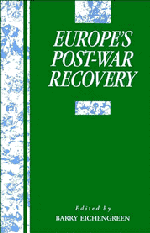Book contents
- Frontmatter
- Contents
- List of contributors
- Preface
- Part I Introduction and survey
- Part II The Marshall Plan
- Part III Other international initiatives
- 4 The IMF and the creation of the Bretton Woods System, 1944–58
- 5 The GATT's contribution to economic recovery in post-war Western Europe
- 6 The European Coal and Steel Community: an object lesson?
- 7 The European Payments Union: an efficient mechanism for rebuilding Europe's trade?
- Part IV Country studies
- Part V Synthesis
- Index
7 - The European Payments Union: an efficient mechanism for rebuilding Europe's trade?
Published online by Cambridge University Press: 07 September 2010
- Frontmatter
- Contents
- List of contributors
- Preface
- Part I Introduction and survey
- Part II The Marshall Plan
- Part III Other international initiatives
- 4 The IMF and the creation of the Bretton Woods System, 1944–58
- 5 The GATT's contribution to economic recovery in post-war Western Europe
- 6 The European Coal and Steel Community: an object lesson?
- 7 The European Payments Union: an efficient mechanism for rebuilding Europe's trade?
- Part IV Country studies
- Part V Synthesis
- Index
Summary
With the disintegration of the Soviet Union, the trade of its successor states has declined precipitously. Enterprises have found it difficult to obtain the imported inputs needed to produce industrial and agricultural outputs that might be exported. Confusion over the availability and acceptability of inter-republican credits has left potential exporters hesitant to sell and potential importers unable to buy. Governments have applied export controls to a variety of products. While estimates of inter-republican trade are notoriously unreliable, the figures suggest a decline in the volume of inter-republican trade of 30–50 percent in 1992 alone, a drop in excess even of the dramatic decline in production.
The problem resembles to a remarkable extent conditions in Western Europe after World War II. Intra-European trade had fallen to negligible levels in the aftermath of the war. It was rebuilt in the second half of the 1940s on the basis of bilateral agreements. The most important step was the European Payments Union inaugurated in 1950. Member countries agreed to accept the currency of any other participant in payment for exports, unsnarling the suffocating tangle of bilateral agreements. Credits were provided to deficit countries, eliminating the need to balance exports and imports by reducing demand and, potentially, employment and growth. Intra-European commerce expanded vigorously, as shown in figure 7.1, permitting the convertibility of currencies for current account transactions to be restored by the end of the 1950s.
The EPU's successful operation renders it an obvious model for a payments union scheme for reconstructing trade among the successor states of the Soviet Union.2 Yet a payments union also has potential costs.
- Type
- Chapter
- Information
- Europe's Postwar Recovery , pp. 169 - 196Publisher: Cambridge University PressPrint publication year: 1995
- 2
- Cited by



